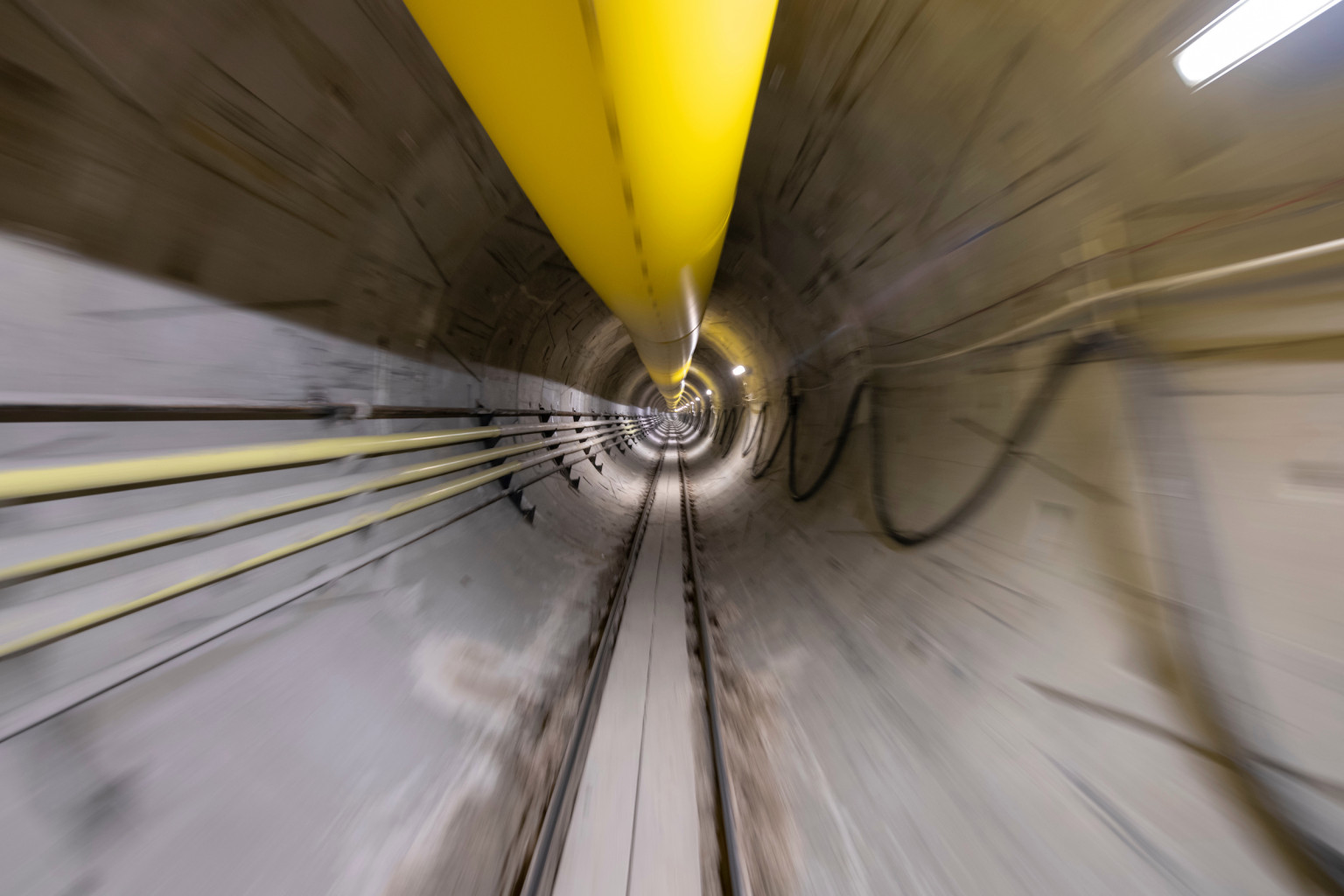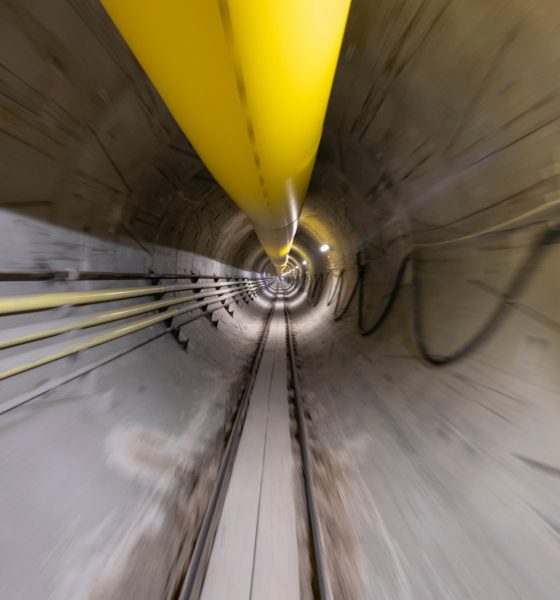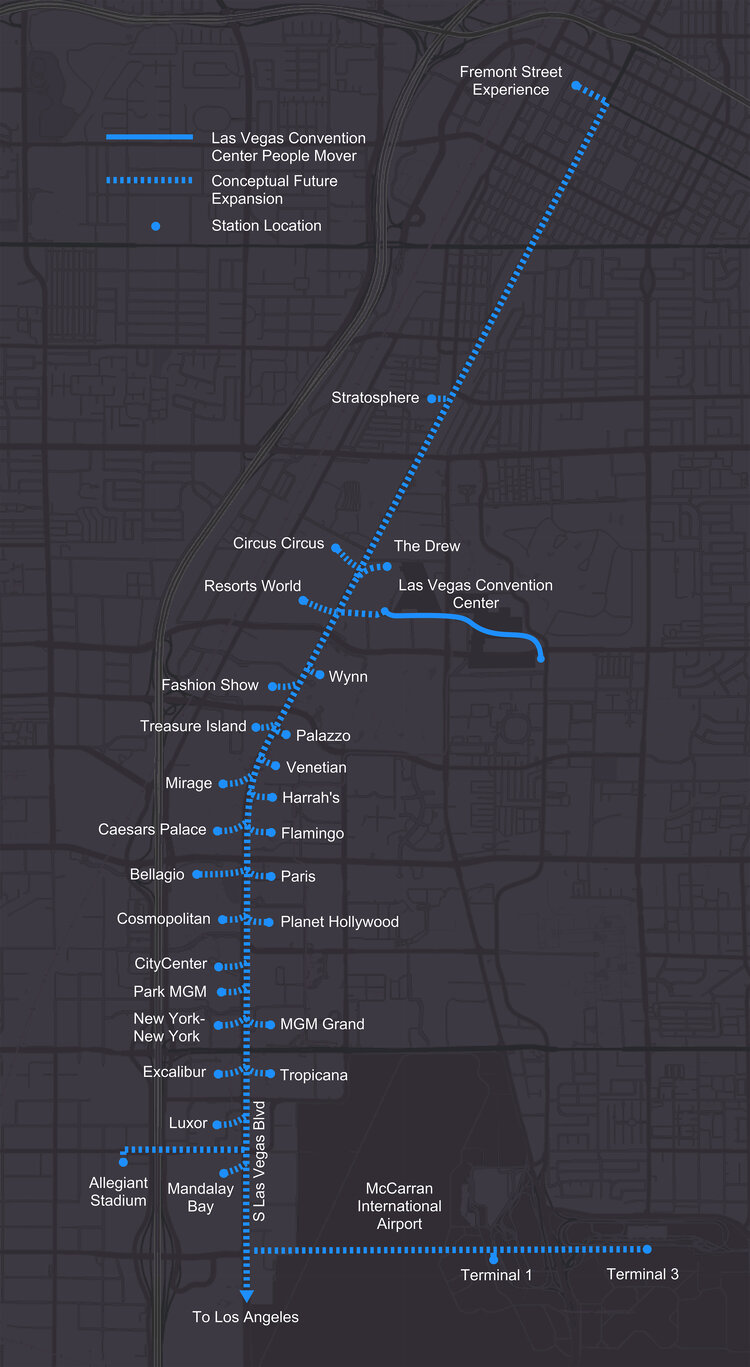

News
The Boring Company’s recently-finished Las Vegas tunnels are only the beginning
Elon Musk has stated that the company’s recently-completed Las Vegas Convention Center tunnels would eventually connect to the city’s hotels and airport. Information from the tunneling startup shows that the tunnel system could eventually stretch as far as Los Angeles, providing a quick, alternative, and sustainable form of transportation for commuters in the area.
Yesterday, Teslarati reported that the Boring Company had officially finished both tunnels for the Las Vegas Convention Center Loop. The system will assist in moving people from one end of the Las Vegas Convention Center to the other.
However, it seems that the project is only the beginning for what could be an expansive tunnel network, after Musk hinted that the tunnels would be expanded from the city’s convention center to the majority of the Las Vegas strip. After the LVCC Loop’s completion, it appears that the Boring Company will be shifting its focus on making the tunnels a city-wide transportation system.
 Boring Co.’s proposed idea for its future “Vegas Loop.” (Credit: lvloop.com/vegasloop)
Boring Co.’s proposed idea for its future “Vegas Loop.” (Credit: lvloop.com/vegasloop)
The Boring Co. recognizes the project as the “Vegas Loop.” The company’s website states that the tunnel “will include the LVCC Loop and any future service extensions including those to casinos along the Strip, McCarran International Airport, Allegiant Stadium (home of the new Las Vegas Raiders), downtown Las Vegas, and eventually to Los Angeles.”
The Boring Co. crews were able to complete the twin tunnels of the LVCC Loop quickly, mostly in part to innovations that the company adopted. The first of the two tunnels was completed in February, with the second being finished in mid-May.
The Loop system at the LVCC is designed to transport passengers who are visiting the complex. A typical walk across the Convention Center usually takes around 15 minutes. However, the implementation of the Boring Co. tunnel will eliminate a significant amount of travel time as passengers will be able to get from one end to the other in just two minutes.
Initially, the system will be using Teslas with safety drivers to transport commuters. Eventually, the Teslas used for the tunnel will be autonomous, CEO and President of the Las Vegas Convention and Visitors Authority Steve Hill says. “Whenever we get to the point where we know that (it’s safe to let the vehicles drive themselves), that’s when we’ll take that step. But there is not a deadline for making that happen,” Hill explained.

News
Nvidia CEO Jensen Huang explains difference between Tesla FSD and Alpamayo
“Tesla’s FSD stack is completely world-class,” the Nvidia CEO said.

NVIDIA CEO Jensen Huang has offered high praise for Tesla’s Full Self-Driving (FSD) system during a Q&A at CES 2026, calling it “world-class” and “state-of-the-art” in design, training, and performance.
More importantly, he also shared some insights about the key differences between FSD and Nvidia’s recently announced Alpamayo system.
Jensen Huang’s praise for Tesla FSD
Nvidia made headlines at CES following its announcement of Alpamayo, which uses artificial intelligence to accelerate the development of autonomous driving solutions. Due to its focus on AI, many started speculating that Alpamayo would be a direct rival to FSD. This was somewhat addressed by Elon Musk, who predicted that “they will find that it’s easy to get to 99% and then super hard to solve the long tail of the distribution.”
During his Q&A, Nvidia CEO Jensen Huang was asked about the difference between FSD and Alpamayo. His response was extensive:
“Tesla’s FSD stack is completely world-class. They’ve been working on it for quite some time. It’s world-class not only in the number of miles it’s accumulated, but in the way it’s designed, the way they do training, data collection, curation, synthetic data generation, and all of their simulation technologies.
“Of course, the latest generation is end-to-end Full Self-Driving—meaning it’s one large model trained end to end. And so… Elon’s AD system is, in every way, 100% state-of-the-art. I’m really quite impressed by the technology. I have it, and I drive it in our house, and it works incredibly well,” the Nvidia CEO said.
Nvidia’s platform approach vs Tesla’s integration
Huang also stated that Nvidia’s Alpamayo system was built around a fundamentally different philosophy from Tesla’s. Rather than developing self-driving cars itself, Nvidia supplies the full autonomous technology stack for other companies to use.
“Nvidia doesn’t build self-driving cars. We build the full stack so others can,” Huang said, explaining that Nvidia provides separate systems for training, simulation, and in-vehicle computing, all supported by shared software.
He added that customers can adopt as much or as little of the platform as they need, noting that Nvidia works across the industry, including with Tesla on training systems and companies like Waymo, XPeng, and Nuro on vehicle computing.
“So our system is really quite pervasive because we’re a technology platform provider. That’s the primary difference. There’s no question in our mind that, of the billion cars on the road today, in another 10 years’ time, hundreds of millions of them will have great autonomous capability. This is likely one of the largest, fastest-growing technology industries over the next decade.”
He also emphasized Nvidia’s open approach, saying the company open-sources its models and helps partners train their own systems. “We’re not a self-driving car company. We’re enabling the autonomous industry,” Huang said.
Elon Musk
Elon Musk confirms xAI’s purchase of five 380 MW natural gas turbines
The deal, which was confirmed by Musk on X, highlights xAI’s effort to aggressively scale its operations.

xAI, Elon Musk’s artificial intelligence startup, has purchased five additional 380 MW natural gas turbines from South Korea’s Doosan Enerbility to power its growing supercomputer clusters.
The deal, which was confirmed by Musk on X, highlights xAI’s effort to aggressively scale its operations.
xAI’s turbine deal details
News of xAI’s new turbines was shared on social media platform X, with user @SemiAnalysis_ stating that the turbines were produced by South Korea’s Doosan Enerbility. As noted in an Asian Business Daily report, Doosan Enerbility announced last October that it signed a contract to supply two 380 MW gas turbines for a major U.S. tech company. Doosan later noted in December that it secured an order for three more 380 MW gas turbines.
As per the X user, the gas turbines would power an additional 600,000+ GB200 NVL72 equivalent size cluster. This should make xAI’s facilities among the largest in the world. In a reply, Elon Musk confirmed that xAI did purchase the turbines. “True,” Musk wrote in a post on X.
xAI’s ambitions
Recent reports have indicated that xAI closed an upsized $20 billion Series E funding round, exceeding the initial $15 billion target to fuel rapid infrastructure scaling and AI product development. The funding, as per the AI startup, “will accelerate our world-leading infrastructure buildout, enable the rapid development and deployment of transformative AI products.”
The company also teased the rollout of its upcoming frontier AI model. “Looking ahead, Grok 5 is currently in training, and we are focused on launching innovative new consumer and enterprise products that harness the power of Grok, Colossus, and 𝕏 to transform how we live, work, and play,” xAI wrote in a post on its website.
Elon Musk
Elon Musk’s xAI closes upsized $20B Series E funding round
xAI announced the investment round in a post on its official website.

xAI has closed an upsized $20 billion Series E funding round, exceeding the initial $15 billion target to fuel rapid infrastructure scaling and AI product development.
xAI announced the investment round in a post on its official website.
A $20 billion Series E round
As noted by the artificial intelligence startup in its post, the Series E funding round attracted a diverse group of investors, including Valor Equity Partners, Stepstone Group, Fidelity Management & Research Company, Qatar Investment Authority, MGX, and Baron Capital Group, among others.
Strategic partners NVIDIA and Cisco Investments also continued support for building the world’s largest GPU clusters.
As xAI stated, “This financing will accelerate our world-leading infrastructure buildout, enable the rapid development and deployment of transformative AI products reaching billions of users, and fuel groundbreaking research advancing xAI’s core mission: Understanding the Universe.”
xAI’s core mission
Th Series E funding builds on xAI’s previous rounds, powering Grok advancements and massive compute expansions like the Memphis supercluster. The upsized demand reflects growing recognition of xAI’s potential in frontier AI.
xAI also highlighted several of its breakthroughs in 2025, from the buildout of Colossus I and II, which ended with over 1 million H100 GPU equivalents, and the rollout of the Grok 4 Series, Grok Voice, and Grok Imagine, among others. The company also confirmed that work is already underway to train the flagship large language model’s next iteration, Grok 5.
“Looking ahead, Grok 5 is currently in training, and we are focused on launching innovative new consumer and enterprise products that harness the power of Grok, Colossus, and 𝕏 to transform how we live, work, and play,” xAI wrote.








